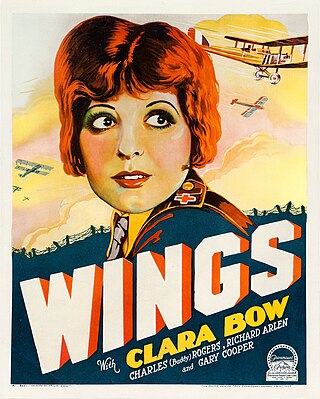
Wings is a 1927 American silent and synchronized sound film known for winning the first Academy Award for Best Picture. Due to the general public's apathy towards silent films, the film was quickly re-released in 1928 with synchronized sound. While the sound version of the film has no audible dialogue, it was released with a synchronized musical score with sound effects. The original soundtrack to the sound version is preserved at UCLA.

The Jazz Singer is a 1927 American part-talkie musical drama film directed by Alan Crosland and produced by Warner Bros. Pictures. It is the first feature-length motion picture with both synchronized recorded music and lip-synchronous singing and speech. Its release heralded the commercial ascendance of sound films and effectively marked the end of the silent film era with the Vitaphone sound-on-disc system, featuring six songs performed by Al Jolson. Based on the 1925 play of the same title by Samson Raphaelson, the plot was adapted from his short story "The Day of Atonement".

A sound film is a motion picture with synchronized sound, or sound technologically coupled to image, as opposed to a silent film. The first known public exhibition of projected sound films took place in Paris in 1900, but decades passed before sound motion pictures became commercially practical. Reliable synchronization was difficult to achieve with the early sound-on-disc systems, and amplification and recording quality were also inadequate. Innovations in sound-on-film led to the first commercial screening of short motion pictures using the technology, which took place in 1923. Before sound-on-film technology became viable, soundtracks for films were commonly played live with organs or pianos.
The following is an overview of 1928 in film, including significant events, a list of films released and notable births and deaths. Although some films released in 1928 had sound, most were still silent. This year is notable for the introduction of the official mascot of The Walt Disney Company, Mickey Mouse, in the animated short Steamboat Willie, the first film to include a soundtrack completely created in post production.

Herbert Brenon was an Irish-born U.S. film director, actor and screenwriter during the era of silent films through 1940.

Clifford Hardman "Clive" Brook was an English film actor.

Mary Brian was an American actress who made the transition from silent films to sound films.
A part-talkie is a sound film that includes at least some "talking sequences" or sections with audible dialogue. The remainder of the film is provided with a synchronized musical score with sound effects. These films more often than not contain a main theme song that is played during key scenes in the film and is often sung offscreen on the musical soundtrack. During the portion without audible dialogue, speaking parts are presented as intertitles—printed text briefly filling the screen—and the soundtrack is used only to supply musical accompaniment and sound effects.

Chinatown Nights, also known as Tong War, is a 1929 film starring Wallace Beery and begun as a silent film then finished as an all-talking sound one via dubbing. Directed by William A. Wellman and released by Paramount Pictures, Chinatown Nights also stars Florence Vidor, former wife of director King Vidor, who did not dub her own voice and quit the movie business immediately afterward, preferring not to work in sound films; her voice in Chinatown Nights was supplied by actress Nella Walker. The supporting cast includes Warner Oland as a Chinese gangster and Jack Oakie as a stuttering reporter. The movie was based upon the story "Tong War" by Samuel Ornitz.

Beggars of Life is a 1928 American part-talkie sound film that was directed by William Wellman. Although the film featured sequences with audible dialogue, the majority of the film had a synchronized musical score with sound effects. The film was released on both sound-on-disc and sound-on-film formats. Currently circulating are mute prints from the sound-on-disc version. The majority of the sound discs are believed to be lost.
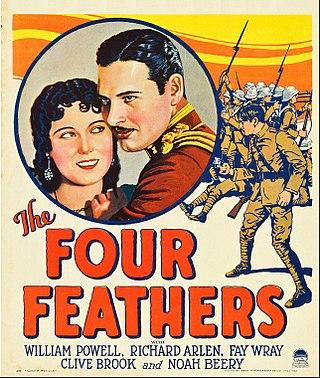
The Four Feathers is a 1929 American sound war film directed by Merian C. Cooper and starring William Powell, Richard Arlen, Clive Brook and Fay Wray. This was the third of numerous film versions of the 1902 novel The Four Feathers written by A. E. W. Mason. While the film has no audible dialog, it was released with a synchronized musical score with sound effects using both the sound-on-disc and sound-on-film process. The 1929 version of The Four Feathers premiered at the Criterion Theatre in New York City on June 12, 1929.

The Canary Murder Case is a 1929 American pre-Code crime-mystery film based on the 1927 novel of the same name by S.S. Van Dine. The film was directed by Malcolm St. Clair, with a screenplay by Wright, Albert Shelby LeVino, and Florence Ryerson. William Powell starred in the role of detective Philo Vance, with Louise Brooks co-starred as "The Canary"; Jean Arthur, James Hall, and Charles Lane also co-starred in other principal roles.
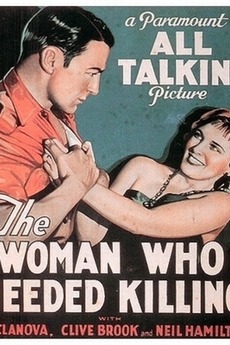
A Dangerous Woman is a 1929 American Pre-Code film released by Paramount, based on the Margery Lawrence story, A Woman Who Needed Killing. It was directed by Gerald Grove and Rowland V. Lee from a script by John Farrow and Edward E. Paramore Jr.
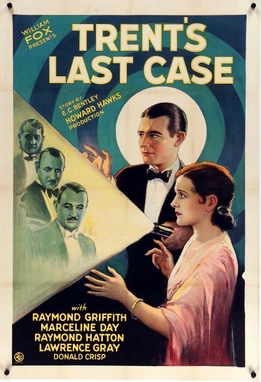
Trent's Last Case is a 1929 American sound part-talkie Pre-Code detective film directed by Howard Hawks and starring Raymond Griffith, Marceline Day, Raymond Hatton, and Donald Crisp. It was released by Fox Film Corporation. In addition to sequences with audible dialogue or talking sequences, the film features a synchronized musical score and sound effects along with English intertitles. The soundtrack was recorded using the Movietone sound-on-film system.

Lothar Mendes was a German-born screenwriter and film director. His two best known films are Jew Süss (1934) and The Man Who Could Work Miracles (1936), both productions for British studios.
The Man I Love (1929) is a part-talking sound film from Paramount Pictures produced in parallel silent and sound versions. This film survives in a copy sold to television in the 1950s. The film stars Richard Arlen. Some sources refer to this as Arlen's first sound film, but he co-starred Nancy Carroll in Dorothy Arzner's Manhattan Cocktail (1928), another part-talking picture released by Paramount.
Roy Pomeroy was an American special effects artist and film director. One of the only three technicians that founded the Academy of Motion Picture Arts and Sciences, he was awarded the Academy Award for Engineering Effects for the film Wings at the 1st Academy Awards.

Forgotten Faces is a 1928 American silent drama film directed by Victor Schertzinger and starring Clive Brook, Mary Brian, and Olga Baclanova. The production was overseen by David O. Selznick, a rising young producer at the time. The film was remade by Paramount in 1936 as a sound film.
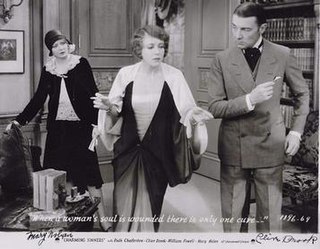
Charming Sinners is a 1929 American pre-Code comedy film directed by Robert Milton and Dorothy Arzner, with a screenplay by Doris Anderson adapted from the 1926 play The Constant Wife written by W. Somerset Maugham. The film stars Ruth Chatterton, Clive Brook, Mary Nolan, William Powell, Laura Hope Crews and Florence Eldridge. The film was released on August 17, 1929, by Paramount Pictures.















